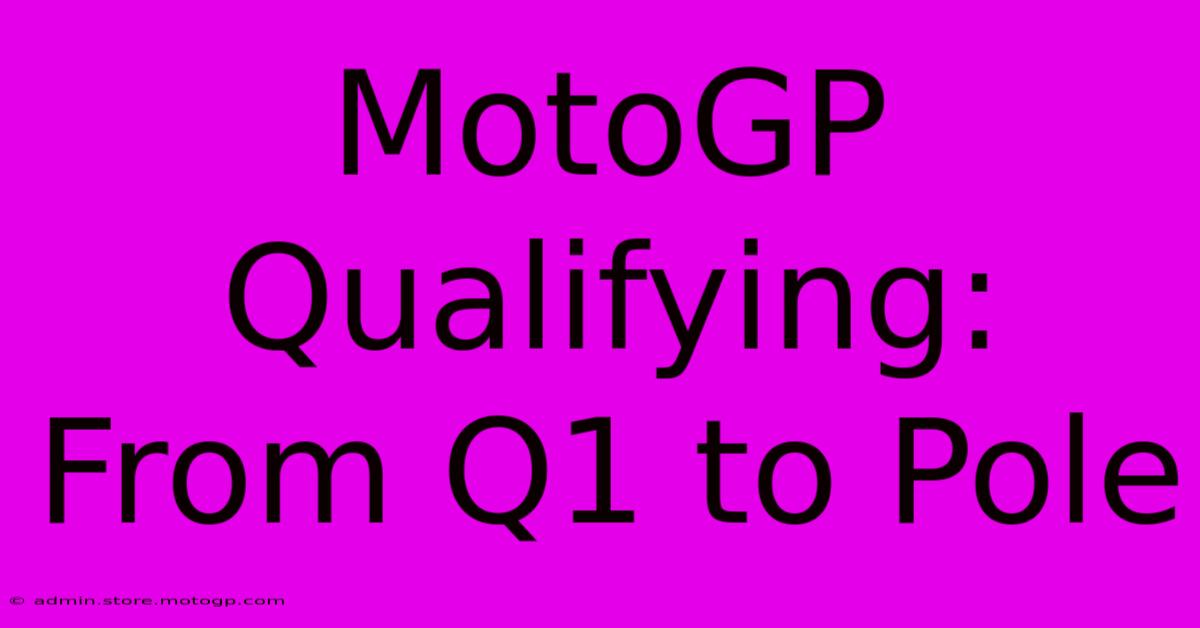MotoGP Qualifying: From Q1 To Pole

Table of Contents
MotoGP Qualifying: From Q1 to Pole Position
MotoGP qualifying is a crucial stage in a Grand Prix weekend, determining the starting grid for the race. The fight for pole position is intense, a battle of speed, skill, and strategy. Let's break down the qualifying process, from the initial Q1 session to the ultimate goal of securing pole.
Understanding the Qualifying Format
The MotoGP qualifying format aims to separate the fastest riders from the rest, creating a thrilling grid for race day. It involves two qualifying sessions: Q1 and Q2.
Q1: The Fight for Q2 Entry
Q1 is where the riders ranked 11th to 20th after the Free Practice sessions compete. This 15-minute session is high-stakes; only the two fastest riders progress to Q2. The pressure is immense, with every tenth of a second counting. This session often witnesses breathtaking overtakes and last-minute improvements, as riders push their machines and themselves to the limit. Strategy plays a key role here; some riders might opt for a cautious approach, saving tires for Q2, while others go all out for a guaranteed Q2 spot.
Q2: The Battle for Pole
The top 10 riders from the combined Free Practice sessions, along with the two fastest riders from Q1, make up the Q2 grid. This 15-minute session is even more intense, with every rider aiming for pole position – the coveted spot on the front row, offering a significant advantage at the race start. Tire management becomes even more critical here, as riders try to balance achieving a fast lap with preserving tire life for the race. The final seconds of Q2 are often nail-biting, with riders vying for those precious tenths of a second to secure the best starting position.
Key Factors Influencing Qualifying Performance
Several factors contribute to a rider's success in qualifying:
1. Bike Setup: A perfectly tuned motorcycle is paramount. The bike's setup directly impacts handling, acceleration, and braking, all crucial for achieving fast lap times. Teams spend countless hours fine-tuning the bike's settings to optimize performance for the specific track.
2. Tire Choice: The choice of tire compounds significantly impacts grip and performance. Finding the right balance between grip and tire life is crucial, especially in Q2 where riders need to balance a fast lap time with tire conservation for the race.
3. Track Conditions: Weather, track temperature, and grip levels all influence lap times. Riders and teams constantly monitor these conditions, adapting their strategies accordingly. A sudden change in weather can completely alter the qualifying landscape.
4. Rider Skill: Ultimately, the rider's skill and experience are the determining factors. A skilled rider can extract the maximum performance from the bike and navigate the track flawlessly, even under pressure. Experience in similar track conditions is also a significant advantage.
The Importance of Pole Position
Securing pole position offers a significant advantage in the race. Starting at the front allows riders to control the pace, avoid early race congestion, and potentially build an early lead. It's a psychological boost too, giving the rider and the team confidence heading into the race.
Beyond the Numbers: The Drama of MotoGP Qualifying
MotoGP qualifying isn't just about lap times; it's a compelling spectacle. The tension, the strategic maneuvers, and the constant pursuit of improvement create a dramatic atmosphere. The final moments of each session are often filled with unexpected twists and turns, making for a thrilling viewing experience. It's a testament to the skill and courage of the riders and the meticulous preparation of the teams. The battle for pole is a microcosm of the entire Grand Prix weekend, a concentrated burst of adrenaline-fueled competition that sets the stage for the main event.
Keywords: MotoGP Qualifying, Q1, Q2, Pole Position, MotoGP, Motorcycle Racing, Grand Prix, Qualifying Format, Race Strategy, Tire Management, Bike Setup, Track Conditions, Rider Skill, Starting Grid, MotoGP Championship
This article incorporates several SEO best practices:
- Keyword Optimization: Strategic placement of keywords throughout the text.
- Header Structure (H2, H3): Clear organization and hierarchy of information.
- Readability: Use of concise sentences, paragraphs, and a conversational tone.
- Content Length: Sufficient length to provide comprehensive information.
- Internal Linking (if applicable): Link to related articles within the site (not included in this example, as it is a standalone piece).
- External Linking (if applicable): Linking to authoritative sources (not included, to avoid any association with particular websites).
By following these guidelines, this article aims to rank well in search engine results and engage readers effectively.

Thank you for visiting our website wich cover about MotoGP Qualifying: From Q1 To Pole. We hope the information provided has been useful to you. Feel free to contact us if you have any questions or need further assistance. See you next time and dont miss to bookmark.
Featured Posts
-
Cota Qualifying The Fastest Qualifier Wins Bragging Rights
Feb 20, 2025
-
Moto Gp Aero Separating Fact From Fiction
Feb 20, 2025
-
Dont Pay A Dime Moto Gp Live Stream Free Online
Feb 20, 2025
-
Moto Gp Photos An Inside Look At The World Of Racing
Feb 20, 2025
-
Safety And Style Moto Gp Helmets Now On Sale
Feb 20, 2025
